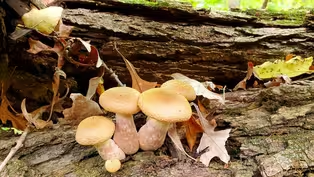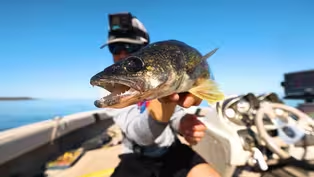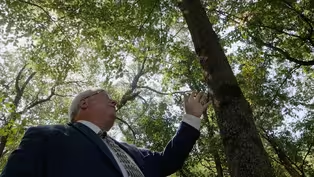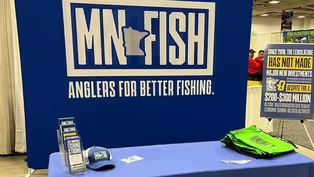Prairie Sportsman
MN-Fish and Biophilia Rx
Season 15 Episode 13 | 27m 46sVideo has Closed Captions
Advocating for fishing in Minnesota and doctors prescribing outdoor therapy.
Host Bret Amundson visits a nonprofit that advocates for fishing improvements in Minnesota and a Mayo Clinic doctor prescribes outdoor therapy for stress-related ailments.
Problems playing video? | Closed Captioning Feedback
Problems playing video? | Closed Captioning Feedback
Prairie Sportsman is a local public television program presented by Pioneer PBS
Production sponsorship is provided by funding from the Environment and Natural Resources Trust Fund, West Central Initiative, Shalom Hill Farm, and members of Pioneer PBS.
Prairie Sportsman
MN-Fish and Biophilia Rx
Season 15 Episode 13 | 27m 46sVideo has Closed Captions
Host Bret Amundson visits a nonprofit that advocates for fishing improvements in Minnesota and a Mayo Clinic doctor prescribes outdoor therapy for stress-related ailments.
Problems playing video? | Closed Captioning Feedback
How to Watch Prairie Sportsman
Prairie Sportsman is available to stream on pbs.org and the free PBS App, available on iPhone, Apple TV, Android TV, Android smartphones, Amazon Fire TV, Amazon Fire Tablet, Roku, Samsung Smart TV, and Vizio.
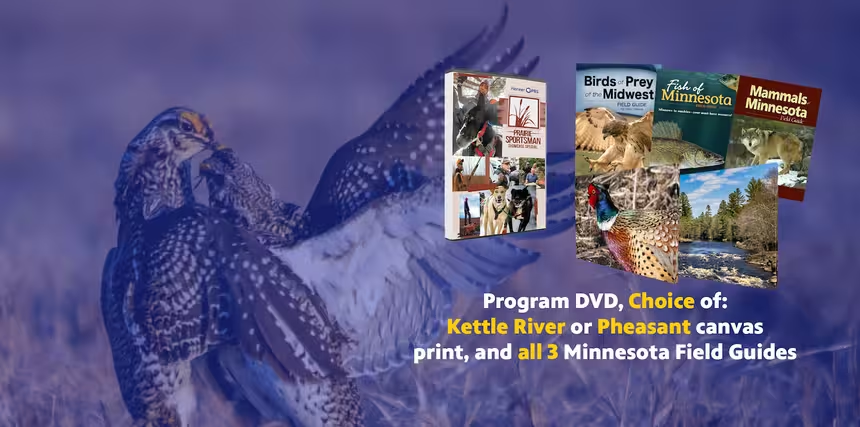
Prairie Sportsman Premium Gifts
Do you love the great outdoors, hunting, fishing, hiking and conservation? Consider becoming a friend of Prairie Sportsman to support the show and receive gifts with your contribution.Providing Support for PBS.org
Learn Moreabout PBS online sponsorship(upbeat music) - On the next "Prairie Sportsman", meet the nonprofit MN-FISH, which advocates for Minnesota fishing interests statewide.
And we'll learn about Mayo Clinic doctors prescribing outdoor therapy.
And we'll join Nicole Zempel for a fast forage.
Welcome to "Prairie Sportsman", I'm Bret Amundson.
If you like the outdoors, sit back and enjoy this brand new episode starting right now.
(mellow music) (upbeat music) - [Voice Over] Funding for "Prairie Sportsman" is provided by the Minnesota Environment and Natural Resources Trust Fund, as recommended by the Legislative Citizen Commission on Minnesota Resources.
Mark and Margaret Yagel-Juline on behalf of Shalom Hill Farm, a retreat and conference center in a prairie setting near Windom, Minnesota, on the web at shalomhillfarm.org.
And by West Central Initiative.
And Western Minnesota Prairie Waters.
And the members of Pioneer PBS.
(mellow music) - [Bret] There's no question that fishing is a tradition rooted in Minnesota.
It's not only a popular hobby for Minnesotans, but it's also a vital piece of the state's economy.
That's why it's important to fight for our rights as anglers and the reason MN-FISH was born.
(mellow music) - You know, MN-FISH was formed in 2018 with 18 volunteer members.
Really wanted to give anglers a bigger, stronger voice in St. Paul with both the DNR, the governor's office and the legislature.
- A group of really avid anglers saw some issues going on up at the Capitol and interacting with legislators found out that they were having a hard time passing some initiatives to help the DNR on a fisheries front.
And legislators were saying, "You know what?
There's no citizen voice up here helping us."
Legislators are asking, 'cause you have 201 legislators and a lot of them didn't understand or don't understand what is all entailed to behind the scenes around fishing.
And so when they were asking for these dollars and no citizen's voice out there, they were having a hard time doing very basic legislation to promote fishing in Minnesota.
From that spurred the action of Ron Scharra and others to create MN-FISH.
- It was guys like John Peterson from Northland Tackle and Babe Winkelman, myself, Ron Scharra, Craig Wilson.
I mean, I'm not gonna get through everybody 'cause there was 18 of us, but really the commitment was I'm at the later stages of my career, whether I'm in industry or an angler and I wanna give back.
And I can recognize the importance of fishing here and we're not seeing that type of response from others.
And we need to make people more aware of what fishing has, you know, in terms of impact for Minnesota.
Hey, we're a 6.3, $6.4 billion industry in Minnesota when we combine it with boating.
That's as big as Mayo Clinic, that's as big as the pork industry.
We need to have a presence there and make sure that really our impact on the state is recognized by our legislatures and the DNR.
- We, in Minnesota, we sell 1.4 million fishing licenses every year.
And then you add on top of that kid fishing opportunists who don't get a license, it's 25 to 30% of the population is actually out angling at some point throughout a year.
So when you do that number across the legislature, 201 legislators, and only 25 to 30% of 'em have ever fished before in their life, there's a lot of background that you have to provide.
Now, there are a lot of issues inside the angling community that anglers want us to talk about.
We kind of pilot, or is it in the micro side where it's an angler desire on how they want to go fish?
Or is it about improving fishing and taking care of the foundational elements that we need to have there to maintain and improve fishing into the future?
And that's the stuff we're focusing on.
- MN-FISH got involved with a lot of things this past year.
One was urban fishing.
I grew up fishing in Minneapolis, you know, stalking the banks of the Shingle Creek and the Mississippi River.
I have a big place in my heart for urban fishing and we've got some tremendous fishing in the Minneapolis area and other urban areas, but we need to make it clear and make it available to others through docks and fishing areas and things.
So MN-FISH was successful in getting 5 million for that this year.
- It's called FIN, it's the Fishing in the Neighborhood program.
And that program is about engaging with kids largely in the urban core and giving them the opportunity to learn how to tie a hook on a line and go fishing at one of the shore fishing or fishing piers throughout the metropolitan area.
That is a component of what DNR does, but then the stocking of those ponds or those smaller lakes out in those neighborhoods, we see that facility to have the capacity to try to do some of that work there also.
(upbeat music) - [Bret] There's also work being done for Minnesota boaters.
- This last year we were able to get $38 million from the legislature to the boat access system.
We're not asking for new from that money, we're asking for that to be reinvested into and rehab the boat access system in the state.
The DNR is operating approximately 1,700 public boat accesses, lakes and rivers.
There's another 1,700 out there managed by cities or the federal government.
So there's 3,000 of them out there that need constant maintenance.
And what we found is we did a 20 year analysis and realized the legislature fundamentally walked away from the boat access system and stopped any maintenance.
I can't explain why, except there was nobody there besides the DNR asking for those dollars to be reinvested.
- You know, without our voice there's decisions being made that are affecting anglers and affecting our resources, but not necessarily in a good way.
So it's important for anglers to get involved and at least support MN-Fish or get involved yourself to make sure that the perspective of anglers is heard.
- In our proposal at the legislature this year, we're asking for $2 million to start the planning process of a new state hatchery in the metropolitan area that not just feeds the metropolitan area from a stocking perspective, but also provides the DNR the backbone of a research station so that they can do the continuous research that they need to do looking into the future.
And educational opportunities, whether it be for the public or for students at the U who are studying fish and wildlife management, that's the kind of a facility, a backbone facility, that can support all different kinds of things around fishing or fisheries in Minnesota, fisheries management.
- [Bret] Earlier this year we got to visit the St. Paul hatchery and see exactly why MN-FISH is pushing for a replacement facility.
(mellow music) - So this is St. Paul state fish hatchery.
So, at this facility we raise walleye, muskie and tiger muskie.
Last year we did a record 41 million walleye eggs.
- Wow.
- Hatched at this facility.
Three different genetic strains.
There has been a hatchery on these grounds since the late 1800s.
- Wow.
- We're almost pushing about, you know, 150 plus years.
This building is about, you know, kind of pushing 90, 100 years old.
- So you could probably go another 100 or 200 years before you need updates, then?
(Genevieve laughing) - I wish it were so nice.
The way that I tell people about it is we are working with water.
And water, you know, can be a very destructive force, you know, like it's an essential force, you know?
It's essential to all life.
But, you know, if you give water enough time, it'll carve a Grand Canyon.
Basically, the last major renovation to this site was the late '80s.
(mellow music) This structure is called a battery.
And that's what we raise the walleye on.
We'll fill, you know, as many jars as we need to, up to about the two and a half quart line.
It won't be upside down, it'll be right side up.
And then they'll be kind of sitting like this.
And it's actually really fun when the walleye hatch, you kind of, you know, you can get close and you can see them, just the little ones that hatch.
Then they go out the tube and they'll snake their way through this entire structure and they go down another pipe right here and come up into this tank right here.
And this is where we can handle them, net them out, get them into the jugs and disseminate them as needed.
(mellow music) Most fish when they hatch have what's called a yolk sack or an egg sack on their abdomen.
And that's what they're eating, feeding off of for those first few hours, days of life.
And how quickly they absorb that is species dependent and also determines when they need to start feeding themselves.
So for a walleye that is 48 hours from when they hatch to when their yolk sack is fully absorbed and they need to start eating.
This is probably, you know, from like, the '70s or '80s.
We've got a lot of wood on some of these structures, which I am just slowly, you know, whether or not I get a big boost of funding or not, I'm slowly trying to chip away at the wood.
You don't really want wood in a hatchery, because it's a porous material and you've got water going.
There are mold spores just in the air that always exist.
And then from the air they can get into the water and they get that nice porous wood to grow in.
And so we're constantly fighting, you know, a lot of those saprolegnia, other pathogens like that.
These tanks are the tanks we raise the muskie in.
And if you can see at the very bottom they've got those feet and if you look closely, some of the feet are like different height.
- Yeah.
- They're starting to corrode away.
And so we're getting to the point where I am gonna have to go buy some cinder blocks or something just to get a little extra support under there just to make sure that, 'cause if those were to fail, it will happen when there's water in it and there's fish in it.
- [Bret] Weight on there, I suppose- - Would be, yeah, which would be quite tragic.
This is where right after the muskie hatch, they come in here.
The muskie have that yolk sack for seven to 10 days, so a lot longer than the walleye, but while they have that sack, they just lay on their sides on the bottom.
That's it, they don't move.
Once they absorb that yolk sack, that's when they will start swimming.
And we call those swim up fry because now they're like not just laying on the bottom anymore.
And then after that they go into the larger tanks.
(mellow music) And this is also what I was talking about.
This is the other entrance to the hatchery.
(mellow music) So this room is a little bit more multipurpose.
The area crews tend to do a lot of off-season work in here.
That's what a lot of these batteries and the concrete buckets are.
We have another fish battery right here, which we use for walleye as well.
And it kind of has the same setup where the, you know, jars are facing up and when the walleye hatch they go zigzagging through the battery and then up into this tank right here.
This battery right here is where we raise the tiger muskie.
And so the tiger muskie, we don't keep for very long.
Once they're in that swim up phase, we sell 'em to private companies.
And then we actually do buy some back in the fall to stock in some of the lakes in the metro.
- [Bret] What do he private companies do with 'em?
- They're just raising 'em.
(mellow music) Some people don't realize how much easier it is to work with a hatchery that has had a little bit more of like, a recent investment into it.
Hatchery technology has really exploded, even just in like, the past 20 years.
- [Bret] You're saying it's not the same as it was in the 1800s?
- No, sadly it's not.
Actually, you know, in a way it was very much the same probably from the late 1800s until the mid to pushing late 1900s.
There were a lot of things that were the very same.
But with technological advancements, just, you know, basically since the 90s, we could do a lot more with less manpower, essentially.
We could do a lot more monitoring, you know, keeping track of, you know, like, are these fish doing okay?
If something, you know, were to go wrong, which, you know, hopefully never happens, but it certainly can, you can have faster response times.
So you can mitigate losses better with just, you know, kind of bringing the hatchery into the 21st century.
(mellow music) - And if you have a failure, whether your generator goes down or a waterline breaks, you lose an entire year's worth of production out of a facility.
You don't get a chance to reboot that.
You don't get a chance to go someplace else and get that fry.
It's done, that year is over.
And you lose millions of fry opportunity for stocking of that year.
And the system, as resourceful and as resilient as the system is, losing that year class is problematic for us.
- We have a similar situation at our Crystal Springs trout hatchery.
The waterline system is about 100 years old and it is still a lot of clay pipe.
It's imminent failure there is a big concern because those clay pipes could collapse at any time.
And we could not only lose, in that case, trout that we're rearing, but also brood stock trout that we hold, which would take in some cases a decade or more to recover.
- There's a lot of people who work really hard in making sure that this place can do what it can do in a given year.
But, you know, there's also the opportunity for us to be able to do so much more.
Just in general, this building is kind of starting to, you kind of start to feel the age of the building.
You know, there were a lot of concerns when they were upgrading that room over there, making sure that, you know, there weren't besides, you know, things like molds, you know, just other, like, asbestos.
Or, you know, just things like that because this building is so old.
If I had the money and I could just gut it and redo it, it would be the plumbing.
Because if you look out here, you know, you just look at all the pipes, it's a lot.
It's even a lot for me as the hatchery manager.
And we've had times where, because, you know, this building is a little bit older and things have kind of been piecemealed together, something will go wrong and it takes us a while to figure out where that problem point is in the lines, because we've got like, back channels and bypasses and cut acrosses and we're like, "What the heck is going on?"
We are missing out on what I think is one of the most important educational opportunities the DNR has to offer.
I can't really open this place up for tours, because, well, there's several reasons.
It's not designed to have safety in mind.
We kind of have, you know, we have a lot of chemicals here and certainly, the people who work here know how to be safe around those chemicals, but we don't have the accessories, the tools needed to keep those away from visitors.
- [Bret] Sure.
- We also have not a whole lot of space right here.
You know, like this open area right here, this is our biggest space right here.
So I can't really have, you know, like, a large group of people coming through.
You know, it's not also in a way designed for tours because there's, you know, you have to walk across these grates.
So there's always trip hazards.
And, you know, I think one of the most pertinent things is I'm not ADA compliant, you know, in any way.
- [Bret] Okay.
- [Genevieve] You know, the door that we walked through?
- Right.
- Step up.
The other way to get in is down the ramp and then up some like, old metal stairs.
So, you know, I can't really open it up, you know, to the public because I can't serve everyone.
- [Bret] Everyone.
- One of the other hatchery managers, when I was talking to 'em about our needs and stuff, said Wisconsin has better hatcheries than Minnesota.
And I think that should be enough for us to pay all of the money that we need.
(both laughing) - [Bret] Even when Minnesota hatcheries are up to date, there'll be other issues to address regarding our future of fishing.
And that's why anglers need to be heard now and in the future.
- Anglers need to recognize that if we don't stand up and raise our hand, we're not gonna be heard and our goals aren't gonna be met because maybe they just don't know what they are or why they're important for us to pursue.
And so it is important for an organization like MN-FISH, and it's important for anglers to get involved and either support it as a member or financially or both.
- It's not a cheap endeavor.
We need the support.
We need anglers to engage and step in and lend their voice to ours.
I mean, we're not the voice, we're just a voice.
And we're just trying to provide that opportunity and that voice out there.
Whether it's with the DNR, with the legislature, to try to improve phishing as we move forward.
But we need your support and your help to make that happen.
(mellow music) (gentle music) - Biophilia is a wonderful concept that we as humans are wired to be connected to nature.
There's something that happens when we see or participate in nature that's good for our bodies.
(gentle music) At Mayo, we've probably had 20 years worth of evaluations of biophilia, a lot more in depth, probably in the last five years.
When you get into nature, it can have direct effects on things like hypertension.
So high blood pressure can very specifically be shown to come down several points just by getting into nature on a regular basis.
Anything that's stress related, could be headaches, could be back pain, could be just that general sensation of stress, probably has the potential to be benefited by getting into nature.
Children with autism who are brought into a city environment and they may be a little more outdoors or into a park, they'll actually have better memory retension, they'll actually have better behavior when they're exposed to nature.
So we know it's really important for young children to be exposed to nature.
It has a lot to do with how their brains develop.
We also know at the other end of the spectrum, very elderly folks who are brought out into a nature setting, better memory, better mood, better blood pressure control.
You're familiar, obviously, with physicians telling us what to do, right?
We have lots of recommendations for you.
It carries a little more weight when I can write a prescription and say, "Please get this filled and take it."
And that works for medications.
Turns out it works that way to get patients into the park.
We can go online, pick a park that's in the patient's area and say, "Hmm, here's a nice park two miles away from your home.
I'm gonna write a prescription for three times a week, 30 minutes at a time, to go out there and take a walk."
(gentle music) You are a Rochester patient and we said, "Eh, I really want you to, you know, get in the parks more."
These are all the Rochester parks.
And we might look and say, "Oh, you're close to Game Haven," so I'll add that.
This is what would print out, or I could send it electronically.
Then there's the link.
You can actually take it off your phone and say, "Yep, I went through and I did it."
It gives you the link to the Game Haven Reservoir Park.
And so now we've taken it from, "I think you should get outside more," to something where you're actually gonna be out a lot more, hopefully.
There's interesting studies that say if we get about two hours per week, that's actually a sweet spot.
If we get less, it's still beneficial, but about two hours.
Well, that's not terribly hard for most of us.
Our culture has really lost connection to nature.
So it's amazing how many people come back and said, "That was one of the most impressive things I've learned from medicine, because it put me back in connection with nature."
We're also very interested in how to get biophilia benefits without it going outside, 'cause not everybody can get outside.
If you've just had a a hip surgery, you're probably not walking outside today.
But we can bring nature into the hospital room.
We've done studies just bringing in recordings of nature in woods like this.
And just playing it through the room can actually shorten length of stay, can reduce pain, can improve satisfaction.
One of the original studies in this whole realm was done back in the early '80s.
And this was looking at patients who had cholecystectomy, or gallbladder surgeries, similar patients and similar hospitals, same surgeons.
And some of the patients had a room that looked out to a brick wall.
And some of the patients had a room where the windows looked out to some shrubbery and trees.
And they just tracked those two groups of patients to see if there was any difference.
And, again, probably not surprising now, but at that time I think fairly striking.
The people who could see some kind of natural element had less pain, were easier to care for, and actually got out of the hospital a little earlier.
If you look at studies where patients have very severe depression, they're hospitalized.
They'd looked at one half of similar patients whose room did not get natural sunlight, and they looked at a group of the same type of patients who got natural sunlight.
And guess who gets out of the hospital sooner at a significant level?
Patients who have natural sunlight.
This isn't just for medicine.
There's interesting studies on productivity, right?
We're all about productivity in this day and age.
They looked at employees in buildings all doing basically the same job.
Telephone calls or telephone center, for example.
And there's some that have outside offices that look into the yards or , you know, brushes outside.
Then there's an inner group that doesn't see quite as much.
And then there's an inner inner group that had no visual content or contact to the outside.
And guess who's more productive?
The folks who have windows, who are doing exactly the same job, eight or 9% more productivity.
If you think about all the things we can do that get us outside the office.
So now we're seeing, of course, walking meetings, we're seeing people do therapy, right?
If we're gonna sit and have a conversation and learn about each other, and I'm gonna try and help you through a therapeutic relationship, can I do that while we walk together?
Turns out we can.
We have many people who live in places where this isn't quite as easy as walking out your back door.
So having plants in the office, having natural elements like wood and stone inside your building can actually have some of the same benefits.
Or I may even just use pictures.
There's interesting studies that if you look at a picture of an nature scene, it can have significant impact on your blood pressure, your heart rate variability, those markers of stress.
If you went back 25 or 30 years ago, there was a lot of debate and it was sort of us versus them.
There was the things that were different or alternative.
Massage, acupuncture, a lot of herbs, people from, at least the medical side, we tended to think of those things as they're out there.
Here's real medicine, this is where the the action is.
And then as we learned more and said, "I can actually reduce your pain if we get you into massage program.
We can see your blood pressure improve if we use acupuncture."
So as we got the evidence, what we've seen is a very nice gradual acceptance and now recognition that part of that lifestyle approach is absolutely integral to what we do from a conventional, if you will, medical practice.
We don't wanna just be the pill pusher or here's a quick fix, we really wanna solve problems.
We wanna work with our patients to optimize their health and wellness, even in the midst of disease.
I think we have to be sensitive currently to the expense of medicine in this country.
It's become outrageous for many patients to afford basic medications and so forth.
So if we do have something in our toolkit that can actually help address your blood pressure without adding yet another pill, why would we not do that?
We do better when we're connected to nature and whether that's financial or health or just general feeling better, it's a great argument for all of us to try and find more time in nature.
(gentle music) (upbeat music) (upbeat music) - So, today, we have had the pleasure of stumbling upon what is commonly called honey mushrooms.
If you are thinking about consuming honey mushrooms and you think you might have identified a honey mushroom, do your due diligence, do a spore print.
There is a good five or six different varieties of honey mushrooms that are edible, of which we will post on the screen for you, because I cannot pronounce it.
I love how somebody described the caps as kind of that five o'clock shadow.
The honey mushroom is a really clean mushroom.
And to me, in my opinion, it more closely resembles like the button mushrooms that you can get from a grocery store.
(mellow music) - [Voice Over] Funding for "Prairie Sportsman" is provided by the Minnesota Environment and Natural Resources Trust Fund as recommended by the Legislative Citizen Commission on Minnesota Resources.
Mark and Margaret Yagel-Juline on behalf of Shalom Hill Farm, a retreat and conference center in a prairie setting near Windom, Minnesota, on the web at shalomhillfarm.org.
And by West Central Initiative.
And Western Minnesota Prairie Waters.
And the members of Pioneer PBS.
(gentle music fading)
Video has Closed Captions
Clip: S15 Ep13 | 4m 20s | Nicole Zempel forages for honey mushrooms. (4m 20s)
Preview: S15 Ep13 | 30s | Advocating for fishing in Minnesota and doctors prescribing outdoor therapy. (30s)
Video has Closed Captions
Clip: S15 Ep13 | 7m 7s | Doctors prescribe outdoor therapy to treat stress-related ailments. (7m 7s)
Video has Closed Captions
Clip: S15 Ep13 | 17m 39s | MN-FISH is fighting for fishing in Minnesota, including pushing for a new hatchery. (17m 39s)
Providing Support for PBS.org
Learn Moreabout PBS online sponsorshipSupport for PBS provided by:
Prairie Sportsman is a local public television program presented by Pioneer PBS
Production sponsorship is provided by funding from the Environment and Natural Resources Trust Fund, West Central Initiative, Shalom Hill Farm, and members of Pioneer PBS.


